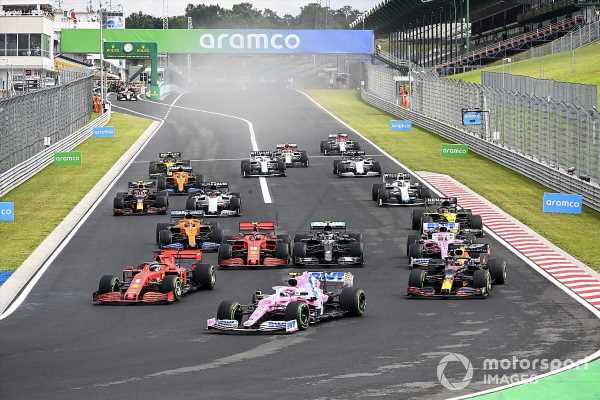Valtteri Bottas avoided a penalty for a suspected jump start in the Hungarian Grand Prix because it didn’t trigger the detection system, according to FIA’s Formula 1 race director Michael Masi.
The Mercedes driver edged forward at the start before stopping and going again when distracted by a light on his dash, leading Sebastian Vettel to tell his Ferrari team that Bottas had jumped the start.
Video evidence appeared to confirm that, but the key to an official transgression is the detection system that is built into the track.
Vettel had similarly escaped punishment at the Japanese Grand Prix last year, when his Ferrari twitched forward before the lights went out.
“There are two parts to that,” explained Masi. “The means by which a false start is determined is actually clearly determined in the sporting regulations, and has been the same process for a number of years, which is the transponder that’s fitted to each car is the judgement mechanism.
“There is a sensor in the road, in the track, as well. “There’s a tolerance within that, and as we saw in Japan last year, that is the determining factor.
“So there was nothing further to have a look at. We spoke to the timekeepers immediately, and they reviewed all the data, and that was the end of the matter.”
While Bottas escaped sanction, Haas drivers Kevin Magnussen and Romain Grosjean both received 10 second penalties for receiving radio messages telling them to pit on the formation lap, a move that saw both drivers climb the order in the opening laps. However such instructions are not permitted.
“There was a technical directive that came out in 2017 clarifying what communications the team cab make to the drivers on the formation lap, which relates to Article 27.1 of the sporting regulations, which is that the driver must drive the car alone, and unaided,” said Masi.
“Part of that summons is that both drivers were called in by their engineers to change tyres on the formation lap, which is not permitted within that technical directive that was issued at the time about what can and can’t [be said].
“In essential terms the only communication that can be made with the driver during the formation lap is to do with safety matters, so if it’s an issue of imminent safety, then that communication can take place.”
Finally, Red Bull Racing was investigated for the unusual offence of drying Alex Albon’s grid spot with blowers, something that Masi had specifically cautioned against in notes sent to teams just before the start. However after reviewing the evidence, the stewards took no action.
“It’s been around for quite a few years,” said Masi of the rule. “It was more just a reminder that I sent out prior to the start of the race, to remind everyone. The stewards investigated and deemed that there was no further action necessary.
“It was a report that was received, and the stewards investigated it, and obviously wanted to investigate it properly, which is why they waited until after the race, because it is something that is quite foreign, let’s call it.
“They did their proper process to make sure it wasn’t something that occurred.”
Source: Read Full Article
